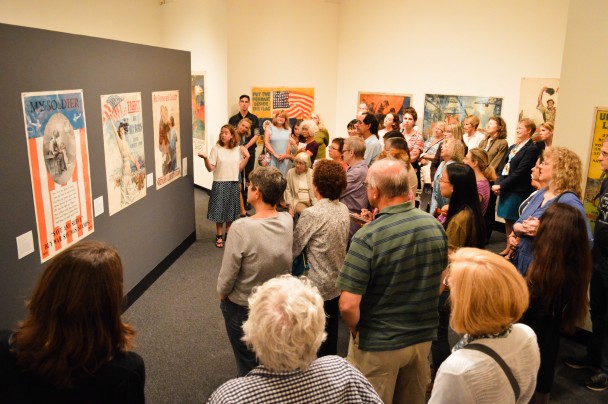"Call To Action" on display at Davison Art Center through Dec. 7.

c/o Nic de Soto-Foley
Victorious men armed for combat and poised women with smiles of support greet you, inviting you in to hear their story. Though the room is small, it quickly becomes clear that their narrative is anything but. Once antiquated WWI propaganda posters, these prints are enlivened, their bright and striking palettes jumping out from the whitewashed walls. Here, history and the visual arts commingle with a politically charged narrative to create a raw, poignant, and intellectual retelling of the past.
On Thursday, Sept. 11, the Davison Art Center (DAC) revealed the long-awaited exhibition “Call to Action: American Posters in World War I,” which showcased a selection of World War I posters from the permanent DAC collection. An impressive group of Wesleyan students, professors, and Connecticut residents huddled into the petite gallery to see these prints firsthand and to better comprehend an intricate history.
Though Claire Rogan, DAC curator, initially conceived of the idea, this exhibition was co-curated by Rogan and Rebecca Wilton ’15, the Jim Dine Curatorial Intern. In explaining the birth of the project, Rogan emphasized the importance of collaborative curation.
“I was looking through the collection and realized that we had this fabulous trove of World War I posters,” Rogan said. “The last time they were exhibited was 1981 and I thought that it was time to exhibit them again. And that’s when Rebecca came in: she had a summer internship here…and she helped me go through those posters and then it evolved into a co-curation scenario where we worked together as a team to select pieces and themes. Rebecca wrote half of the labels and I wrote the other half.”
According to Rogan, more than one hundred WWI posters in the DAC collection had to be examined and ltered. While many of these posters were American, some were French or British. Due to their age, some posters showed more damage than others, a key element in the selection process.
As part of her internship, Wilton was introduced to the field of conservation, a key component in the handling and exhibition of vintage and antique works.
“I subsequently worked with the conservator at Yale University, Theresa Fairbanks Harris, to repair some of the small tears and losses in the posters and really work with them in a hands-on way,” Wilton said.
The chosen prints were in excellent condition and the surfaces were barely indicative of age. Perhaps their most striking features were their large size and dramatic coloring.
“Posters have to grab the audience,” Rogan said. “They have to be visually so succinct and direct. And these are incredibly effective, even one hundred years later.”
Katherine Du ’15 said she was struck by the design elements upon seeing the exhibition.
“I’ve always been interested in this age of illustration,” Du said. “I loved seeing the artists’ particular strength in creating the figures and the strong design sensibilities and the visual strategies used to drive an emotional point.”
In addition to being visually captivating, these pieces brought out many evocative narratives that arose from the war, including racial and gender constructions, the redefinition of the nation, and the skepticism and tension that arose on the home front and abroad.
Rogan explained the importance of constructing national identity and the insurmountable role that these posters had in propagating certain ideals.
“One thing that really struck me is that this is about constructing public opinion, and it’s about constructing national identity,” Rogan said. “We have one [poster] that says, ‘Americans Are,’ and it lists all of these immigrant names. It says that it is this government-sponsored attempt to bring everyone together in a common cause when there are very good reasons for people to be skeptical. It’s about the construction of the nation, construction of U.S. as world power, motivating the front.”
Rogan also elaborated on the gender constructs that were emphasized during the war, as they appeared in these posters.
“One thing that really hit me is that the last wave of scholarship has been the construction of masculinity, not just how women should be, but how men should be,” she said.
One fascinating thing about speaking with both Rogan and Wilton about this exhibit was the clear difference in their exposures to and experience with the war. Wilton noted this difference herself, and she spoke about how this altered her educational and emotional experiences with the work.
“What I find really fascinating, perhaps because I’m a really young person, is that a lot of these posters are directed towards adults but also likely people that were my age and were being recruited,” Wilton said. “Learning about the expectations and values that American had, or were supposed to have, is a little shocking to me but also very interesting.”
Everyone should take a break from their textbooks to visit this exhibition (up through Dec. 7) and explore these visceral and tangible pieces of the past. Historical, emotional, and visually stunning, this exhibition unearths a history frequently forgotten and addresses issues with varying degrees of scholarship and interpretation. Most of all, it revealed the importance of the visual in understanding our past, and that sometimes all it really takes is a second look.
Comments are closed